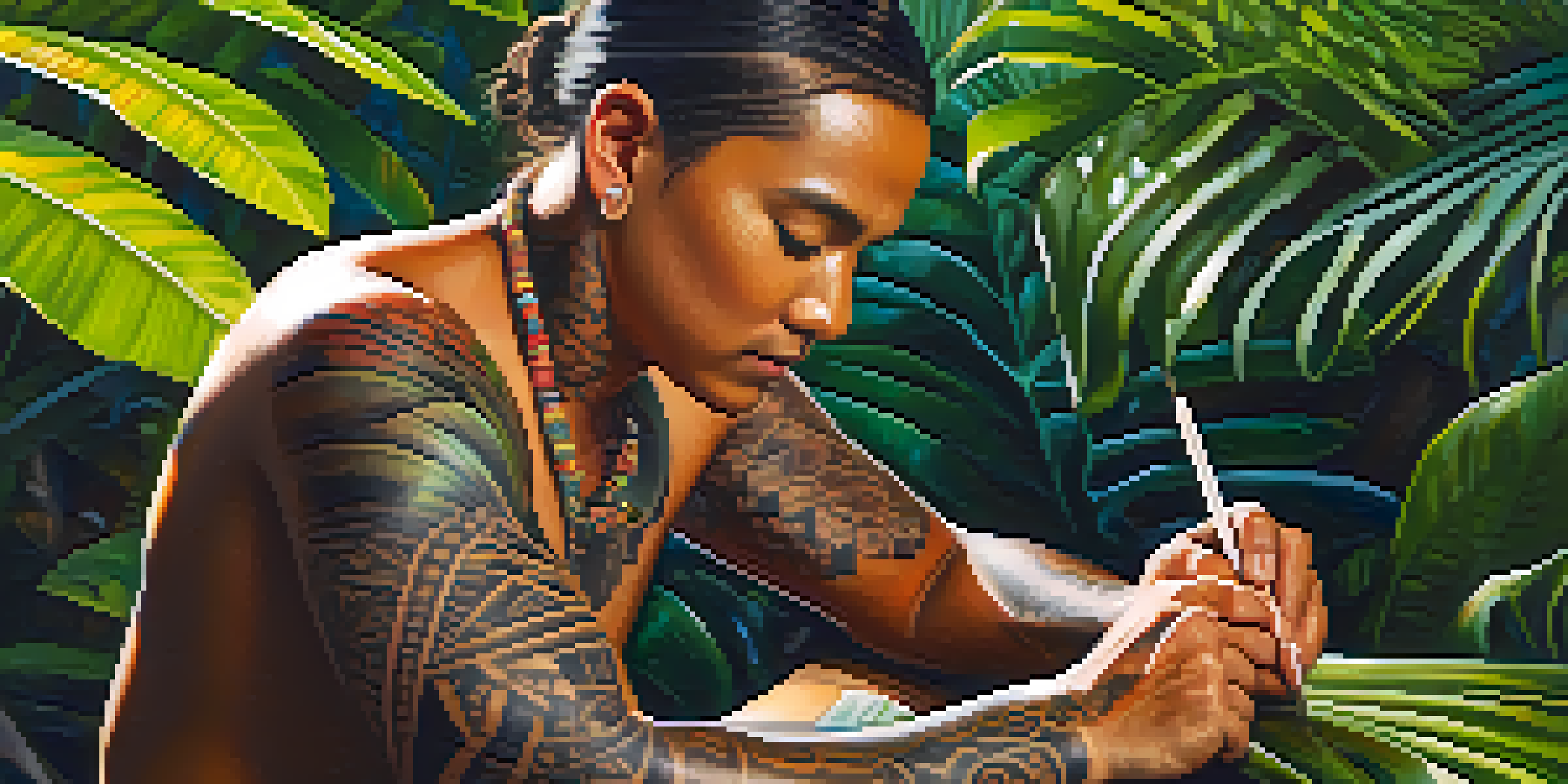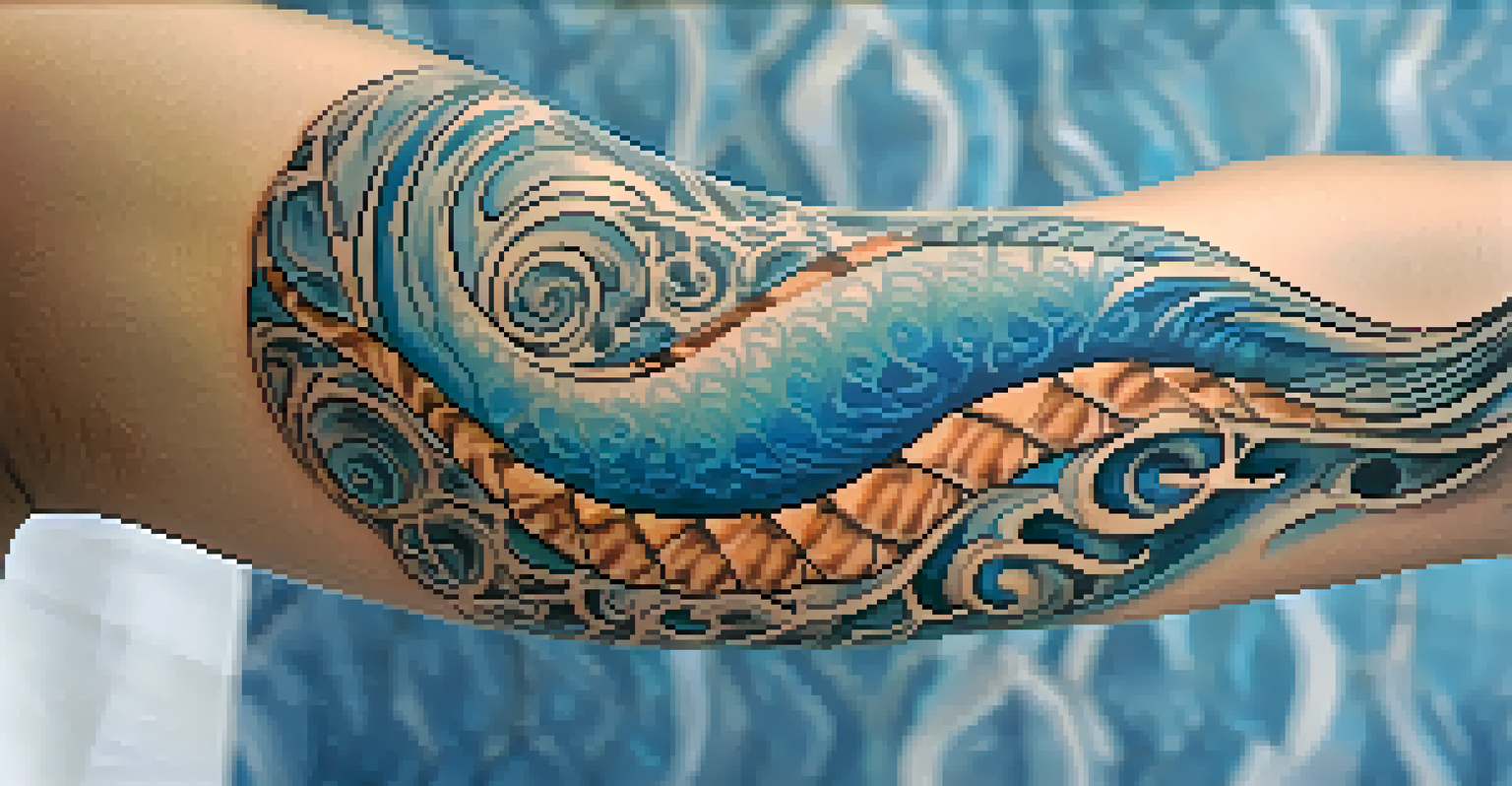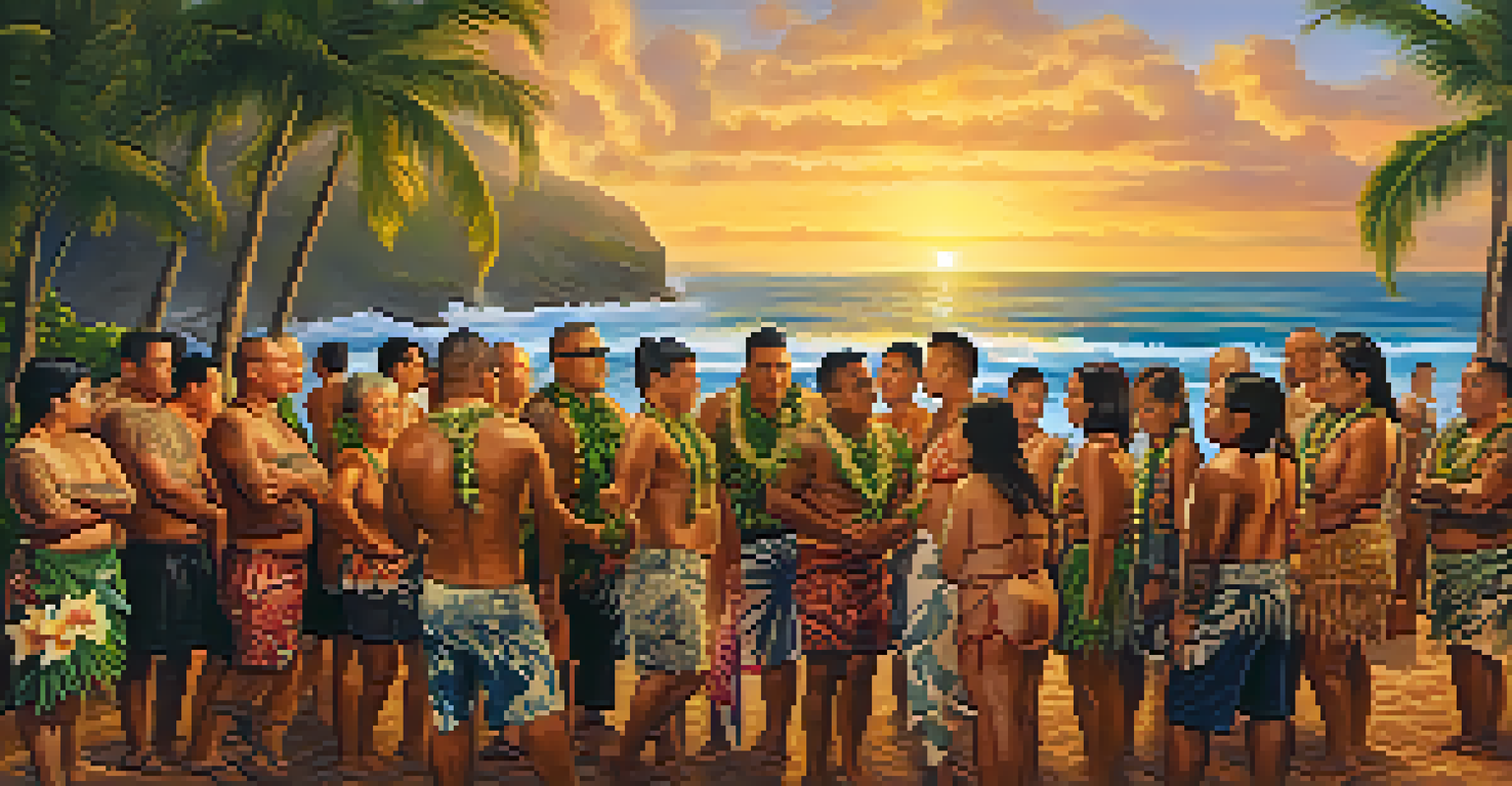Exploring the Origins of Hawaiian Tattoo Art and Its Evolution

Understanding the Cultural Significance of Tattoos in Hawaii
In Hawaiian culture, tattoos, or 'kakau', have deep roots that go beyond mere body art. They serve as a form of identity, representing ancestry, social status, and personal achievements. Each tattoo tells a story, often passed down through generations, which connects individuals to their heritage and community.
Tattoos are a way of telling your story without saying a word.
Traditionally, the process of getting a tattoo was a sacred ritual involving chants and prayers, emphasizing its spiritual significance. It was not uncommon for individuals to undergo elaborate ceremonies before receiving their tattoos, reflecting their importance in Hawaiian life. This cultural depth adds layers of meaning to each design, making them unique to each wearer.
Moreover, tattoos in Hawaii were often associated with specific roles within society. For instance, warriors might have tattoos that symbolized strength and bravery, while women could showcase designs that represented fertility and protection. Thus, tattoos became a visual language, communicating much about the wearer’s place in society.
The Tools and Techniques Used in Traditional Hawaiian Tattooing
Traditional Hawaiian tattooing employed tools made from natural materials, including shark teeth, bone, and wood. These tools were crafted with care, ensuring that each piece was not only functional but also imbued with cultural significance. The art of tattooing was often a family trade, passed down through generations of skilled artisans.

The technique of 'kakau' involves tapping the tattoo tool into the skin, a method that requires precision and patience. The rhythmic sound of the tool striking the skin was often accompanied by chants, creating a meditative atmosphere that honored the art form. This connection between the artist and the recipient is a reminder of the bond they share through the tattooing process.
Tattoos as Cultural Identity
In Hawaiian culture, tattoos, or 'kakau', represent ancestry, social status, and personal achievements, serving as a profound expression of identity.
As time passed, Western influences introduced new tools and methods, leading to a transformation in traditional practices. However, many artists today strive to preserve the ancient techniques, ensuring that the cultural essence of Hawaiian tattooing remains intact.
The Evolution of Designs in Hawaiian Tattoo Art
Originally, Hawaiian tattoo designs were geometric and abstract, often inspired by nature and mythology. Common motifs included waves, sea creatures, and symbols representing fertility and strength. These designs were not arbitrary; they held significant meanings that resonated with the individual and their life experiences.
A tattoo is a permanent reminder of a temporary feeling.
As Hawaiian tattoo art evolved, artists began to incorporate elements from other cultures, blending traditional designs with modern influences. This fusion has led to a resurgence of interest in tribal and contemporary styles, appealing to a broader audience. The result is a vibrant tapestry of tattoo art that honors its roots while embracing innovation.
Today, many tattoo artists strive to balance traditional significance with contemporary aesthetics, creating pieces that resonate personally with clients. This evolution showcases the adaptability of Hawaiian tattoo art, proving that it can honor its history while still evolving in a modern context.
The Role of Hawaiian Tattoo Artists in Preserving Culture
Hawaiian tattoo artists play a crucial role in preserving and promoting the rich history of 'kakau'. Many artists are deeply connected to their heritage, often sharing stories of their ancestors and the meanings behind various designs. This commitment to education not only enriches the tattooing experience but also fosters a greater appreciation for Hawaiian culture.
In recent years, there has been a growing movement among artists to reclaim traditional practices. Workshops and cultural events are held to educate both artists and clients about the significance of Hawaiian tattoos, ensuring that the art form is practiced with respect and understanding. This revival helps to keep the traditions alive and relevant.
Traditional Techniques and Tools
Traditional Hawaiian tattooing utilized natural materials and sacred rituals, emphasizing the cultural significance and spiritual connection involved in the process.
Furthermore, these artists often collaborate with cultural practitioners to ensure that the tattooing process honors Hawaiian customs. By doing so, they bridge the gap between the past and present, ensuring that future generations can appreciate and celebrate the beauty of Hawaiian tattoo art.
Modern Perceptions of Hawaiian Tattoos in Popular Culture
Hawaiian tattoos have gained significant popularity in mainstream culture, often seen as trendy body art. This surge in interest has led to a mix of appreciation and appropriation, with some individuals adopting designs without understanding their cultural significance. This phenomenon raises important questions about respect and authenticity in the world of tattooing.
While many people admire Hawaiian tattoos for their beauty, it's essential to recognize the stories and meanings behind them. Educating oneself about the cultural context can foster deeper connections between the art and the individual wearing it. Many artists encourage clients to explore the history of 'kakau' before choosing a design, ensuring a more meaningful experience.
As the popularity of Hawaiian tattoos continues to grow, it presents an opportunity for cultural exchange. By sharing the significance of these tattoos, artists can help promote awareness and respect for Hawaiian culture, fostering a greater appreciation for its traditions in a global context.
The Future of Hawaiian Tattoo Art and Its Cultural Impact
Looking ahead, the future of Hawaiian tattoo art holds exciting possibilities as artists continue to blend tradition with modern techniques. The growing interest in cultural authenticity encourages a new generation of tattoo artists to engage with their heritage and explore innovative ways to express it. This evolution may lead to fresh interpretations of traditional designs, making them relevant for contemporary society.
Moreover, the increasing global recognition of Hawaiian culture can create platforms for artists to showcase their work on broader stages. Events like tattoo conventions and cultural festivals provide opportunities for artists to share their skills and stories, connecting with enthusiasts worldwide. This visibility can help preserve the significance of Hawaiian tattoos and educate others about their importance.
Modern Challenges and Opportunities
The popularity of Hawaiian tattoos in mainstream culture presents both challenges of appropriation and opportunities for cultural exchange and education.
Ultimately, the future of Hawaiian tattoo art rests on the balance between honoring tradition and embracing change. As long as artists and clients remain committed to understanding the cultural roots of 'kakau', Hawaiian tattoo art will continue to thrive and inspire future generations.
Celebrating the Legacy of Hawaiian Tattoo Art
Celebrating the legacy of Hawaiian tattoo art means recognizing its historical and cultural significance. It is essential to honor the artisans who have kept this practice alive, ensuring that the stories and meanings behind each design are preserved for future generations. By acknowledging the past, we can appreciate the art form's evolution and its role in modern society.
Community events and educational initiatives play a pivotal role in celebrating Hawaiian tattoo culture. By bringing together artists, historians, and enthusiasts, these gatherings foster a sense of unity and shared appreciation for the art form. They serve as a reminder of the importance of cultural exchange and understanding.

In conclusion, Hawaiian tattoo art is not merely a trend; it is a profound expression of identity, culture, and history. As we explore its origins and evolution, we are invited to celebrate the beauty and significance of 'kakau', ensuring that this rich tradition continues to inspire and connect people for years to come.